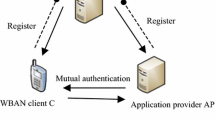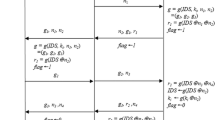Abstract
Radio frequency identification (RFID) technology will become more popular in various applications in the near future. But the security issues in RFID systems have hindered this technical promotion seriously. The extant RFID security protocols have serious insufficiency and flaws to resistance trace attacks and desynchronization attacks. In this paper, we propose a security protocol that can against the intermittent position trace attacks and desynchronization attacks. We prove the security of the proposed protocol by data reduction method with the learning parity with noise and formally verify the functionality of the proposed scheme by using Colored Petri Nets.
Similar content being viewed by others
References
Rivest, R. L. (1992). The MD5 message digest algorithm, Request for Comments (RFC)132. Available:http://people.csail.mit.edu/rivest/Rivest-MD5.txt.
FIPS PUB 180-1, ed: National Institute of Standards and Technology 1995 April 17. Available:http://www.itl.nist.gov/fipspubs/fip180-1.htm.
FIPS PUB 180-2, ed: National Institute of Standards and Technology 2002 August 1. Available:http://www.itl.nist.gov/fipspubs/fip180-1.htm http://csrc.nist.gov/publications/fips/fips180-2/fips180-2withchangenotice.pdf .
Sarma S. E., Weis S. A., Engels D. W. (2003) Radio-frequency identification: Secure risks and challenges. RSA Laboratories Cryptobytes 6(1): 2–9
Weis, S. A. (2003). Security and privacy in radio-frequency identification devices, Master’s thesis, Massachusetts Institute of Technology (MIT), May 2003.
Juels, A., Rivest, R. L., & Szydlo, M. (2003). The blocker tag: Selective blocking of RFID tags for consumer privacy. In Proceedings of the l0th ACM conference oil computer and communications security (CCS 2003) (pp. l03–111).
Sarma, S. E., Weis, S. A., & Engels, D. W. (2003). RFID systems and security and privacy implications. In Proceedings of 4th International work-shop on cryptographic hardware and em bedded systems (CHES 2002) (pp. 454–469).
Weis, S. A., Sarma, S. E., Rivest, R. L., & Engels, D. W. (2004). Security and privacy aspects of low-cost radio frequency Identification systems. In Proceedings of the lst international conference on security in pervasive computing (pp. 20l–212).
Ohkubo, M., Suzuki, K., & Kinoshita, S. (2004). Hash-chain based for-ward-secure privacy protection scheme for low-cost RFID. In Proceedings of 2004 symposium on cryptography and information security (SCIS 2004).
Henrici, D., & Muller, P. (2004). Hash-based enhancement of location privacy for radio-frequency identification devices using varying identifiers. In Proceedings of 2nd IEEE annual conference on pervasive computing and communications workshops 2004, (PERC0M W’04), Vol. 9 (pp. 149–153).
Peris-Lopez, P. (2006). M2AP: A minimalist mutual-authentication protocol for low-cost RFID tags. In Proceedings of third international conference ubiquitous intelligence and computing (UIC-06) (pp. 1–12).
Peris-Lopez, P., Hernandez-Castro, J. C., & Estevez-Tapiador, J. M. (2006). EMAP: An efficient mutual authentication protocol for low-cost RFID tags. In OTM 2006 Workshops (pp. 352–361).
Peris-Lopez, P., Hernandez-Castro, J. C., & Estevez-Tapiador, J. M. (2006). LMAP: A real lightweight mutual authentication protocol for low-cost RFID tags. In Hand. of workshop on RFID and lightweight crypto.
Chien H. Y. (2007) SASI: A new ultralightweight RFID authentication protocol providing strong authentication and strong integrity. IEEE Transaction of Dependable and Secure Computing 3(4): 337–340
Hopper, N. J., & Blum, M. (2001). Secure human identification protocols. In Presented at the advances in cryptology-ASIACRYPT 2001 (pp. 52–66).
Juels, A., & Weis, S. A. (2005). Authenticating pervasive devices with human protocols. In Presented at the advanced in cryptology-CRYPTO’05 (pp. 293–308).
Bringer, J., Chabanne, H., & Dottax, E. (2006). HB++: A lightweight authentication protocol secure against some attacks. In: Proceedings of IEEE international conference on pervasive services workshop on security.
Blurn, A., Furst, M., & Keams, M. (1993). Cryptographie primitives based on hard leaming problems. In Advances in cryptology-CRYPTO’93.
Molnar, D., & Wagner, D. (2004). Privacy and security in library RFID: Issues, practices, and architectures. In Proceedings of 11th ACM conference on computer and communications security (CCS’04), Vol. 5 (pp. 1–19).
Peris-Lopez, P., Hernandez-Castro, J. C., & Tapiador, J. M. E. (2009). Advances in ultralightweight cryptography for low-cost RFID tags: Gossamer protocol. In Information security applications: 9th International workshop (WISA) (pp. 56–68).
Zhou, S., Zhang, Z., & Luo, Z. (2010). A lightweight anti-desynchronization RFID authentication protocol. Information Systems Frontiers, 12, 521–528.
Sun H. M., Ting W. C., Wang K. H. (2011) On the security of Chien’s ultralightweight RFID authentication protocol. IEEE Transaction on Dependable and Secure Computing 8: 315–317
Author information
Authors and Affiliations
Corresponding author
Rights and permissions
About this article
Cite this article
Gao, L., Ma, M., Shu, Y. et al. A Security Protocol Resistant to Intermittent Position Trace Attacks and Desynchronization Attacks in RFID Systems. Wireless Pers Commun 68, 1943–1959 (2013). https://doi.org/10.1007/s11277-012-0770-8
Published:
Issue Date:
DOI: https://doi.org/10.1007/s11277-012-0770-8




